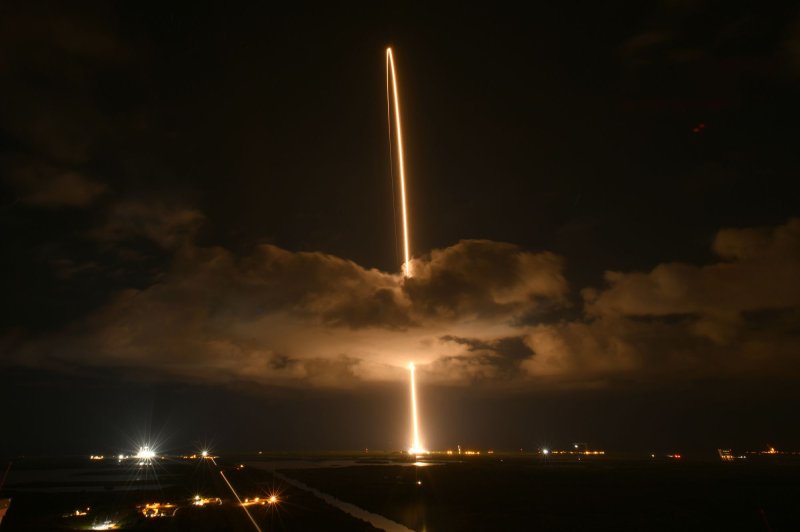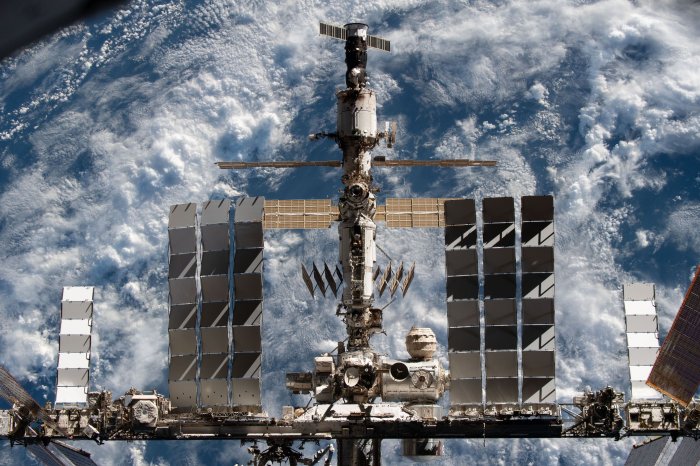1 of 2 | A United Launch Alliance Atlas V rocket boosting NASA's Lucy spacecraft launched at 5:34 a.m. Saturday from Complex 41 at the Cape Canaveral Space Force Station, Florida. Photo by Joe Marino/UPI |
License Photo
Oct. 16 (UPI) -- NASA's Lucy spacecraft launched pre-dawn Saturday in Florida for its 12-year mission to visit eight mysterious asteroids.
A United Launch Alliance Atlas V rocket boosting the spacecraft launched from Complex 41 at the Cape Canaveral Space Station at 5:34 a.m. EDT.
The space agency's goal is to learn about the mysterious dark Trojan asteroids that travel ahead and behind Jupiter in its orbit about 400 miles from Earth's orbit. NASA believes the asteroids date to the beginning of the solar system.
Lucy is a the agency's first mission to Jupiter's Trojan asteroids, and will fly by seven Trojan asteroids and one main belt-asteroid, representing the agency's first single spacecraft mission in history to explore so many different asteroids.
"Lucy embodies NASA's enduring quest to push out into the cosmos for the sake of exploration and science, to better understand the universe and our place within it," said NASA Administrator Bill Nelson in a statement. "I can't wait to see what mysteries the mission uncovers!"
NASA has spent about $981 million on the 12-year mission, which it approved in 2017.
"Today's launch marks a genuine full-circle moment for me as Lucy was the first mission I approved in 2017, just a few months after joining NASA," Thomas Zurbuchen, associate administrator for the Science Mission Directorate at the agency's headquarters in Washington, said in a statement. "A true mission of discovery, Lucy is rich with opportunity to learn more about the mysterious Trojan asteroids and better understand the formation and evolution of the early solar system."
Lucy separated from the second stage of the rocket about an hour after the launch and its massive solar arrays, each nearly 24 feet wide, unfurled about 30 minutes later and began charging batteries to power its subsystems, according to the NASA statement.
At 6:40 a.m., Lucy sent its first signal to Earth from its own antenna to NASA's Deep Space Network. It is now traveling at roughly 67,000 mph on a path that will orbit the sun and come back to Earth a year later for its first gravity boost.
The first gravity boost will propel it beyond Mars. In 2024, the second Earth flyby for gravity boost will propel it toward the Donaldjohanson asteroid in the solar system's main asteroid belt in 2025. In 2031, a third gravity boost will propel it to the Trojans on the other side of Jupiter's orbit in 2033.
The third gravity boost will also assist with a flyby of unusual twin asteroids -- Patroclus and Menoetius -- orbiting each other, according to the Southwest Research Institute.
"One of the really surprising things about the Trojans is how different they are from one another, particularly with their colors," Hal Levison, the SWRI's principal investigator, told CBS News. "Some are gray, some are red ... We think the color indicates different formation locations, and these things were mixed together during the last gasp of planet formation."
"So if you want to understand what this population is telling us about how the planets formed, you need to understand that diversity," Levison added. "And that's what Lucy is intended to do. And we do this through this really amazing trajectory that was part science, part art and part luck."
The International Space Station is pictured from the SpaceX Crew Dragon Endeavour during a flyaround of the orbiting lab that took place following its undocking from the Harmony module’s space-facing port on November 8. Photo courtesy of NASA
















